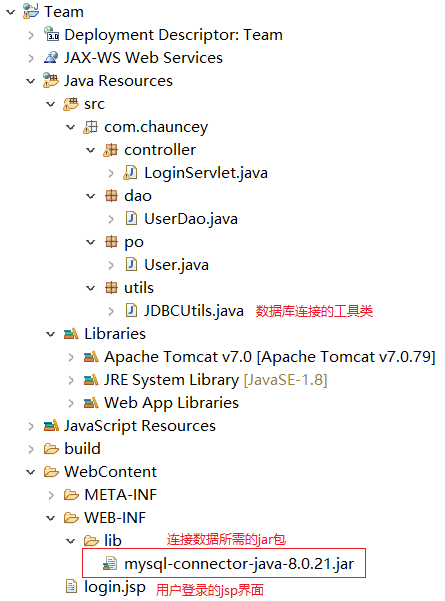JavaWeb —— JDBC 用户登录验证
一、目录结构

二、登录界面
1 <%@ page language="java" contentType="text/html; charset=utf-8" 2 pageEncoding="utf-8"%> 3 <!DOCTYPE html> 4 <html> 5 <head> 6 <meta charset="utf-8"> 7 <title>登录界面</title> 8 </head> 9 <body> 10 <form action="login" method="post"> 11 用户名:<input type="text" name="name"><br> 12 密 码:<input type="text" name="pwd"><br> 13 <input type="submit" value="登录" > 14 <input type="reset"> 15 </form> 16 </body> 17 </html>
三、实体类
1 package com.chauncey.po; 2 3 import java.io.Serializable; 4 5 @SuppressWarnings("serial") 6 public class User implements Serializable { 7 private Integer id; 8 private String name; 9 private String psw; 10 public User() { 11 12 } 13 public Integer getId() { 14 return id; 15 } 16 public void setId(Integer id) { 17 this.id = id; 18 } 19 public String getName() { 20 return name; 21 } 22 public void setName(String name) { 23 this.name = name; 24 } 25 public String getPwd() { 26 return psw; 27 } 28 public void setPwd(String pwd) { 29 this.psw = pwd; 30 } 31 }
四、JDBC工具类
1 package com.chauncey.utils; 2 /* 3 * 数据库连接 4 * 5 */ 6 import java.sql.Connection; 7 import java.sql.DriverManager; 8 import java.sql.ResultSet; 9 import java.sql.SQLException; 10 import java.sql.Statement; 11 12 public class JDBCUtils { 13 //加载驱动,并建立数据库连接 14 public static Connection getConnection() throws SQLException, ClassNotFoundException { 15 //加载驱动 16 Class.forName("com.mysql.cj.jdbc.Driver"); 17 //jdbc:mysql://localhost:3306/user?useSSL=false&serverTimezone=UTC&characterEncoding=utf-8&autoReconnect=true 18 String url = "jdbc:mysql://localhost:3306/info?useSSL=false&serverTimezone=UTC"; 19 String user = "root"; 20 String password = "*****";//数据库的登录密码 21 Connection con = DriverManager.getConnection(url, user, password); 22 return con; 23 } 24 //关闭数据库,释放连接 25 public static void release(Statement st,Connection con) { 26 if (st != null) { 27 try { 28 st.close(); 29 } catch (SQLException e) { 30 // TODO Auto-generated catch block 31 e.printStackTrace(); 32 } 33 st = null; 34 } 35 if (con != null) { 36 try { 37 con.close(); 38 } catch (SQLException e) { 39 // TODO Auto-generated catch block 40 e.printStackTrace(); 41 } 42 con = null; 43 } 44 } 45 //释放资源时先执行该方法 46 public static void release(ResultSet rs,Statement st,Connection con) { 47 if (rs !=null) { 48 try { 49 rs.close(); 50 } catch (SQLException e) { 51 // TODO Auto-generated catch block 52 e.printStackTrace(); 53 } 54 rs = null; 55 } 56 release(st, con); 57 } 58 }
五、数据访问UserDao
1 package com.chauncey.dao; 2 /** 3 * 查询数据库验证登录 4 * 5 */ 6 import java.sql.Connection; 7 import java.sql.ResultSet; 8 import java.sql.Statement; 9 10 import com.chauncey.utils.JDBCUtils; 11 12 public class UserDao { 13 Connection con = null; 14 Statement st = null; 15 ResultSet rs = null; 16 17 public boolean find(String name,String pwd) { 18 //获取数据库连接 19 try { 20 con = JDBCUtils.getConnection(); 21 st = con.createStatement(); 22 23 String sql = "select * from user where name = '"+name+"' and pwd = '"+pwd+"'"; 24 rs = st.executeQuery(sql); 25 if(rs.next()) { 26 return true; 27 }else { 28 return false; 29 } 30 } catch (Exception e) { 31 e.printStackTrace(); 32 }finally { 33 JDBCUtils.release(rs, st, con); 34 } 35 return false; 36 } 37 38 }
六、控制层LoginServlet
1 @WebServlet("/login") 2 public class LoginServlet extends HttpServlet { 3 private static final long serialVersionUID = 1L; 4 5 public LoginServlet() { 6 7 } 8 9 protected void doGet(HttpServletRequest request, HttpServletResponse response) throws ServletException, IOException { 10 response.setContentType("text/html;charset=utf-8"); 11 request.setCharacterEncoding("utf-8"); 12 PrintWriter out = response.getWriter(); 13 UserDao userDao = new UserDao(); 14 String name = null; 15 String sname = request.getParameter("name"); 16 if(sname!=null && sname.trim().length()>0) { 17 name = sname; 18 } 19 String pwd = null; 20 String spwd = request.getParameter("pwd"); 21 if(spwd!=null && spwd.trim().length()>0) { 22 pwd = spwd; 23 } 24 boolean tf = userDao.find(name, pwd); 25 if (tf) { 26 out.print("登录成功"); 27 }else { 28 out.print("用户名或密码错误"); 29 } 30 31 } 32 33 protected void doPost(HttpServletRequest request, HttpServletResponse response) throws ServletException, IOException { 34 doGet(request, response); 35 } 36 37 }
七、数据库创建
1 CREATE DATABASE info; 2 USE info; 3 4 CREATE TABLE USER( 5 id INT(11) NOT NULL AUTO_INCREMENT PRIMARY KEY, 6 NAME VARCHAR(20), 7 pwd VARCHAR(30) 8 ) 9 INSERT INTO USER VALUES(NULL,'小明','xiaoming'); 10 INSERT INTO USER VALUES(NULL,'小王','123456');
效果图:





